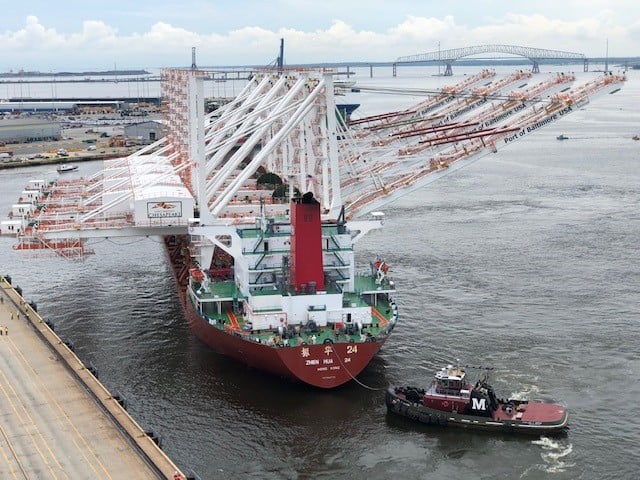Last week, you probably saw a lot of photos and videos on social media of monstrous cranes making their way up the Bay to the Port of Baltimore. Here are some more details on what those cranes mean for Baltimore.

Following a two-month journey that included dramatic passage under the Chesapeake Bay Bridge and the Francis Scott Key Bridge, four new, massive NeoPanamax container cranes arrived September 9, 2021 at the Helen Delich Bentley Port of Baltimore’s Seagirt Marine Terminal. The cranes were delivered aboard the Zhen Hua 24 from China, and were greeted by officials from the Maryland Department of Transportation Maryland Port Administration (MDOT MPA) and its public-private partner, Ports America Chesapeake.
“This is a great day for the Port of Baltimore and for the men and women who make up its outstanding workforce,” said Governor Larry Hogan, who joined Port and MDOT officials to view the cranes as they made the final leg of their journey. “The Port’s container business has grown impressively in recent years and is poised to grow even more with the addition of these new ultra-large cranes. Thanks to our MDOT MPA team and our partners at Port America Chesapeake, the Port of Baltimore is well-positioned to continue as one of Maryland’s prime economic engines.”
“Baltimore is already one of the few ports on the East Coast capable of accommodating the world’s largest container ships,” MDOT secretary Greg Slater said. “These new cranes will allow the Port to serve two ultra-large container ships simultaneously, boosting our capacity and giving us the opportunity to increase revenue and grow the jobs that help fuel Maryland’s economy.”
The new cranes are fully electric, and thus emit no diesel emissions. Each measures 450 feet tall and weighs about 1740 tons—25 feet taller and 190 tons heavier than the Port’s first set of Neo-Panamax cranes that arrived in 2012. The new cranes can each extend to reach 23 containers across on a ship and lift 187,500 pounds of cargo. Ports America Chesapeake will test and prepare the cranes over the next few months, and they are expected to be fully operational in early 2022.
Continued Expansion
The cranes are part of a significant expansion by Ports America Chesapeake at Seagirt to provide greater capacity and efficiency to handle anticipated increases in container volumes. The $166 million investment in terminal and yard upgrades includes a second, 50-foot-deep berth to accommodate mega-ships; new container handling equipment such as 15 hybrid-electric gantry cranes; and a new truck gate complex.
Containers coming through the Port of Baltimore have increased significantly since MDOT MPA and Ports America Chesapeake entered into a public-private partnership agreement in 2010. In 2009, the year prior to the agreement, Seagirt handled 257,367 containers. In 2020, after the first 10 years of the agreement, Seagirt handled 628,132 containers, an increase of 144 percent.
Complementing the new Seagirt berth are plans to expand Baltimore’s Howard Street Tunnel, which will allow for double-stacked container rail cars to travel to and from the Port, clearing a longtime hurdle and giving the East Coast seamless double-stack capacity from Maine to Florida. The project involves clearance improvements in the tunnel and at 22 other locations between Baltimore and Philadelphia. With the tunnel expansion project, Baltimore will be able to send double stacked containers by rail into the Ohio Valley and onto Chicago. In June, the project received final federal environment approval under the National Environmental Policy Act.
The Howard Street Tunnel project benefits from public-private investment from the federal government, Maryland, CSX, and others, and is expected to increase the Port’s business by about 160,000 containers annually. It will also generate about 6,550 construction jobs and an additional 7,300 jobs from the increased business.
The Port of Baltimore generates about 15,300 direct jobs, with nearly 140,000 jobs overall linked to Port activities. The Port ranks first among the nation’s ports for volume of autos and light trucks, roll on/roll off heavy farm and construction machinery, and imported gypsum. It ranks 11th among major U.S. ports for foreign cargo handled and 10th for total foreign cargo value.
To read the full press release, visit the Maryland Port Administration website.